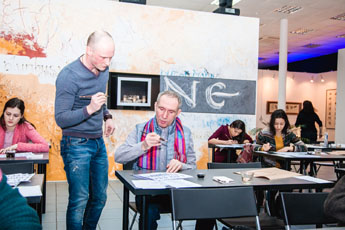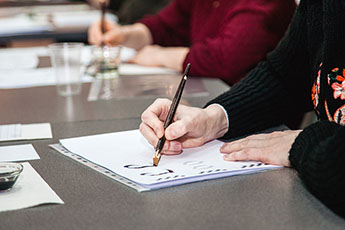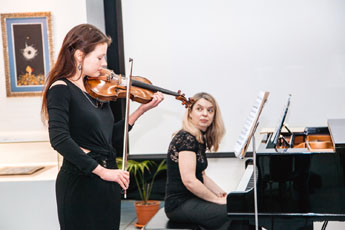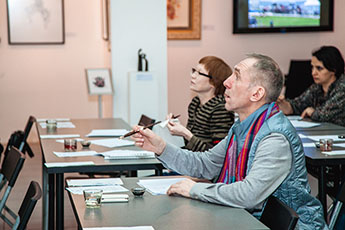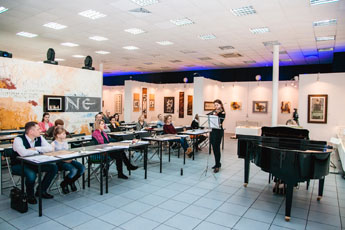Calligraphy, music and love
Last Sunday, February 12th, was dedicated to the theme of love at the Contemporary Museum of Calligraphy: participants of the Calligraphy and Music About Love workshop discussed and were taught to write about love the way it was done in the past, in those times when fine writing with a nib and ink was a mundane thing and not something exotic.
The first part of the workshop was hosted by Mark Yakimenko, calligrapher and designer. He offered the participants to look into the 8th century, when Blackletter dominated in Europe. Of course it’s impossible to fit all the information about the Gothic scripts in all their variety into a small workshop, but Mark tried to cover the most important aspects and peculiarities of the script. Summing up, he suggested that the Blackletter will always remain popular, for it is a very expressive and at the same time very flexible script, offering innumerable opportunities for artistic interpretation.
The practical part of this experience was to write the phrase “Love and respect” on a piece of stylized paper, roll it as a parchment and seal with wax. The phrase is homage to the outstanding philosopher of the 8th century Immanuel Kant who believed that love and respect are our main responsibilities before each other.
When the ink had dried down and the wax had frozen, it was time for the music. The musical programme illustrating the historical themes of the day was provided by Galina Skobeleva on the violin and Marina Yablokova on the piano. The same way as calligraphy scripts carry the print of the epoch when they were in use, telling us about the traditions of those times, music also reflects the moods and stories of the time when it was composed. And those present at the event could experience this very vividly: at first, the musicians performed the Violin Concerto in Three Movements by Ludwig van Beethoven that highlighted the strict and pompous style of Blackletter; and after that the light and romantic Valse-Scherzo by Pyotr Ilyich Tchaikovsky announced the passage of the event programme to the 19th century.
The audience was enchanted by the passionate performance of the musicians, with some seating still, deep in their thoughts, while others couldn’t help taking the pen and letting out their emotions onto the paper. The atmosphere demonstrated yet again the strong and vivid bonding between music and calligraphy, the bonding pinned down in the formula ‘Calligraphy is music for the eyes’.
After the concert, it was Katerina Orfanova’s turn to offer an insight into the history of the Copperplate script that originated in the 16th century and has been popular ever since, just as Blackletter. After some practice with the pointed pen and contour sheets, the participants guided by Katerina created a beautiful composition with a quotation from the Russian 19-century poet Valery Bryusov, arranged it on the paper in accordance with the historical traditions of the time, and sealed it with wax and seal.
We were happy to have everyone at the Museum and look forward to having new people at our events!
